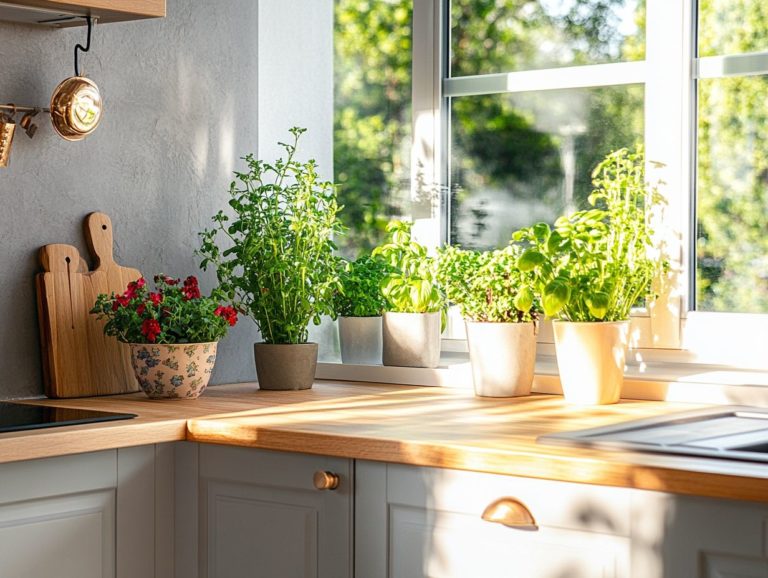Budgeting for Kitchen Ventilation Systems
A well-ventilated kitchen isn’t just a luxury; it’s essential for your health, safety, and efficiency.
Proper ventilation can eliminate smoke, odors, and excess moisture. This transforms cooking into a more enjoyable experience.
This article explores different kitchen ventilation systems. You’ll learn key factors to consider when budgeting, along with installation and maintenance costs.
Discover tips for saving money without sacrificing quality. Understanding kitchen ventilation is crucial for creating a successful cooking space.
Contents
- Key Takeaways:
- Understanding the Importance of Kitchen Ventilation
- Types of Kitchen Ventilation Systems
- Factors to Consider When Budgeting for Kitchen Ventilation
- Cost Analysis of Kitchen Ventilation Systems
- Installation and Maintenance Costs
- Tips for Budgeting and Saving on Kitchen Ventilation
- Frequently Asked Questions
- What factors should I consider when budgeting for a kitchen ventilation system?
- What types of kitchen ventilation systems are available and how do they differ in cost?
- Is it worth investing in a more expensive kitchen ventilation system?
- Are there any ways to save money when budgeting for a kitchen ventilation system?
- What are some common maintenance costs associated with kitchen ventilation systems?
- Is it possible to install a kitchen ventilation system myself to save money?
Key Takeaways:

Proper ventilation is vital for a safe and functional kitchen. It prevents health hazards and keeps the air fresh.
Consider kitchen size, cooking equipment, and local regulations when budgeting for your ventilation system.
Though initial costs may be high, proper maintenance can lead to long-term savings. Look for ways to cut costs without losing quality.
Understanding the Importance of Kitchen Ventilation
Kitchen ventilation significantly impacts your health and comfort. It helps dissipate cooking odors, reduces humidity, and improves air quality.
Good airflow boosts energy efficiency and helps you meet safety regulations. Key appliances like range hoods and exhaust fans combat grease buildup and carbon monoxide risks.
Recognizing the importance of kitchen ventilation is the first step toward a safer cooking environment.
Why Proper Ventilation is Essential for a Kitchen
Proper kitchen ventilation manages cooking odors, maintains air quality, and enhances energy efficiency. Inadequate airflow can lead to harmful gas accumulation and allergens like dust and mold.
This can affect your health and well-being. Ensuring effective ventilation creates a safer cooking atmosphere.
A well-designed system helps you comply with safety regulations, contributing to a successful, functional kitchen remodel.
Types of Kitchen Ventilation Systems
There are various kitchen ventilation systems to meet your unique cooking needs. Your options include:
- Ducted and ductless range hoods
- Under-cabinet hoods
- Wall-mounted hoods
- Island ranges
- Downdraft ranges
- Over-the-range microwaves
Each type serves a specific purpose, ensuring a comfortable and efficient cooking space.
Overview of Different Options
By exploring various range hood types, you unlock functionalities and styles suited to your kitchen design. Each option has its advantages and disadvantages, impacting your cooking experience and kitchen aesthetics.
Ducted hoods are efficient, venting smoke and odors outside. However, they require careful installation planning due to ductwork.
Ductless systems are easier to install, filtering air internally. They’re ideal for kitchens without external ventilation, but you may need to change filters more often for optimal performance.
By considering these factors and maintenance requirements, you can make informed decisions that meet your needs and design aspirations.
Factors to Consider When Budgeting for Kitchen Ventilation

When budgeting for kitchen ventilation, it’s crucial to consider various factors.
Take into account installation costs, labor expenses, and additional costs related to your kitchen’s layout and specific ventilation needs.
Size and Layout of Kitchen
The size and layout of your kitchen are vital in determining the most effective ventilation system. This can significantly influence your installation costs.
In smaller kitchens, achieving proper airflow can be challenging where every inch counts. Selecting a compact yet efficient ventilation solution is essential.
Large kitchens often need robust systems that can handle higher outputs while maintaining a comfortable atmosphere.
Your choice of ventilation should consider the kitchen’s design, the type of cooking you do, and the potential for heat and odor buildup.
Aligning the ventilation method with your kitchen’s dimensions and activities helps achieve optimal air quality.
Types of Cooking Equipment
The cooking equipment you choose significantly influences your ventilation system, especially in managing cooking odors and ensuring sufficient exhaust capacity.
If you opt for commercial-grade stoves that generate more heat, you’ll need range hoods with higher CFM, which measures airflow.
Conversely, standard household appliances typically have less demanding ventilation needs.
The configuration of your range hood—whether wall-mounted or under-cabinet—plays a crucial role in optimizing airflow efficiency.
Exhaust fans contribute to energy conservation by effectively removing smoke and steam, maintaining a healthy kitchen environment and controlling energy costs.
By carefully selecting your cooking equipment and its corresponding ventilation, you ensure both safety and comfort take center stage in your culinary space.
Local Building Codes and Regulations
Adhering to local building codes and safety regulations is essential during your kitchen remodel, especially when installing a new ventilation system.
Understanding these regulations can significantly impact your installation costs and the choices available for ventilation systems.
Some areas may require hoods that meet specific airflow rates or noise level standards, which could increase equipment costs or complicate installation procedures.
Compliance with safety regulations ensures that vital elements like proper ductwork and fire safety measures are in place.
Familiarizing yourself with these requirements aids in selecting the right systems, contributing to a safe and efficient kitchen environment.
Cost Analysis of Kitchen Ventilation Systems
Conducting a cost analysis of kitchen ventilation systems requires assessing the initial investment along with the potential long-term savings from energy-efficient models and lower maintenance expenses.
This thorough evaluation helps you make smart choices that save money!
Initial Investment vs. Long-Term Savings

Analyzing your initial investment in energy-efficient kitchen ventilation systems against long-term savings reveals a compelling case.
Despite higher upfront costs, you can reap significant future benefits.
These systems reduce energy consumption, leading to lower monthly utility bills.
By easing the strain on your heating and cooling systems, they effectively lower maintenance costs over time.
The cumulative savings from reduced energy use can offer substantial financial relief in the long run.
Many homeowners find that these systems foster a healthier living environment and align with their long-term financial goals.
Start planning your kitchen ventilation today to enjoy a healthier home tomorrow!
Installation and Maintenance Costs
Understanding installation and maintenance costs is crucial as you plan to add or upgrade your kitchen ventilation system. These expenses can vary significantly depending on whether you choose professional installation or take the DIY route.
What to Expect in Terms of Installation and Maintenance Expenses
When budgeting for a kitchen ventilation system, it’s important to know the installation and maintenance expenses you’ll encounter, as these can impact your overall costs.
You’ll find various types of range hoods—like under-cabinet, wall-mounted, and island models—each with its own installation costs. The complexity of the setup and the materials chosen will significantly influence these expenses.
For instance, a simple under-cabinet model may require less labor and typically ranges from $200 to $500. In contrast, a more elaborate island hood could elevate installation costs to over $1,000.
Don’t forget about ongoing maintenance. Filter replacements and routine cleaning can add to your overall budget. Plan for these expenses to avoid any unexpected financial strain during your kitchen renovations, ensuring your ventilation system remains efficient and effective for many years to come.
Tips for Budgeting and Saving on Kitchen Ventilation
Effective budgeting for kitchen ventilation requires a clear understanding of installation and maintenance costs, along with strategic tips to save money without compromising quality or performance.
Ways to Cut Costs Without Sacrificing Quality
- Time your purchases during seasonal sales or major holidays to enjoy significant price reductions.
- Explore various brands to find options that deliver similar performance at a more attractive price point.
- Consider models with lower maintenance costs over their lifespan; this choice can lead to substantial savings over time.
By prioritizing long-term value over just the initial cost, you position yourself for a sustainable solution that enhances both your budget and the environment.
Frequently Asked Questions

What factors should I consider when budgeting for a kitchen ventilation system?
When budgeting for a kitchen ventilation system, consider the size and layout of your kitchen, the types of cooking equipment you have, and the level of ventilation required for your needs. Also, factor in the cost of installation and ongoing maintenance.
What types of kitchen ventilation systems are available and how do they differ in cost?
There are several types of kitchen ventilation systems available, including range hoods, downdraft vents, and island hoods. Costs can vary based on factors such as the size and power of the unit, the type of filtration system used, and any additional features like lighting or remote control capabilities.
Is it worth investing in a more expensive kitchen ventilation system?
Consider your specific needs and budget when deciding on a kitchen ventilation system. A more expensive system may offer additional features and better performance, but a less expensive option may still meet your needs. Weigh the cost against the benefits to find the best fit for you!
Are there any ways to save money when budgeting for a kitchen ventilation system?
One way to save money is to opt for a ductless system, which eliminates the need for costly ductwork installation. Research and compare prices from different manufacturers and consider purchasing a refurbished or gently used unit.
What are some common maintenance costs associated with kitchen ventilation systems?
Common maintenance costs include regular filter replacements, cleaning of the unit and ductwork, and any necessary repairs. It’s crucial to factor in these ongoing costs when budgeting for your system.
Is it possible to install a kitchen ventilation system myself to save money?
Thinking about a DIY kitchen ventilation system? It might seem like a smart way to save money, but it can be risky!
We do not recommend installing a kitchen ventilation system yourself. It can lead to a wrong setup and potential dangers.
Hiring a professional ensures a safe and correct installation, giving you peace of mind in your kitchen.





